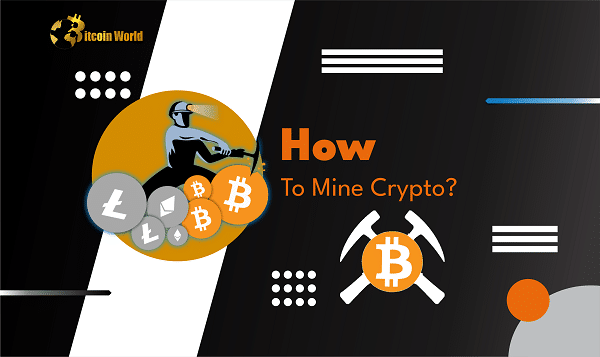The crypto mining industry has the potential to provide passive revenue. This step-by-step overview can help you get started mining on your own. But bear in mind that there are several methods and strategies for mining. Because of this, some mining techniques may not work well with these steps, while others may need additional precautions.
Also keep in mind that mining is not always simple or profitable because it might be subject to changing energy prices and volatile cryptocurrency exchange rates. In addition to the initial investment, it necessitates that you appropriately configure the mining equipment and that you make payments to keep the operation functioning.
1. Choose your Crypto
Cryptocurrencies’ mining challenges vary. The effort needed by the network to mine a block is referred to as the difficulty. Hashing difficulty rises as a result of increased competition when more miners join the network. On the other hand, the hashing difficulty decreases as miners leave the network, making it simpler to mine new blocks.
It’s more difficult for individual miners to make money mining the largest cryptocurrencies because their requirements are so difficult to meet. To maximize their chances of being rewarded, bitcoin miners utilize strong ASICs and mining pools.
Other than bitcoin, Proof of Work (PoW) cryptocurrencies like Dogecoin and Ethereum Classic are frequently mined. Altcoin networks may not be as crowded and provide better chances for smaller miners.
Due to their untapped potential, altcoins can also have a higher growth potential. Additionally, because they don’t need as much processing power, mining alternatives can be used that consume less energy.
However, keep in mind that mining for alternative cryptocurrencies can be more unstable. In the worst case scenario, the protocol could be compromised or abandoned, rendering the tokens useless. It’s also possible that you will need to upgrade your mining equipment and spend more money than you had anticipated because some cryptocurrencies are becoming more and more popular. For instance, mining bitcoin used to be possible just through computers, but that is no longer the case.
2. Choose your Mining Equipment
One type of competition is the mining of cryptocurrencies. Strong mining equipment helps miners in the competition since it increases their likelihood of mining the next block. As previously noted, ASIC miners are created with a single, clear goal in mind, which frequently makes them the best choice for bitcoin mining. However, GPUs are still useful in some networks. However, the effectiveness of GPUs depends on the algorithm and mining difficulty of the cryptocurrency.
Additionally, some cryptocurrencies need mining equipment made specifically for them. For instance, Helium’s crypto miner makes use of radio technology; to give wireless network coverage, the gadget is situated in a location with an open view.
Therefore, you should always confirm what hardware is required for mining the cryptocurrency you want to use.
3. Set up a Crypto Wallet
You’ll also require a cryptocurrency wallet to keep the keys to the coins you obtain through mining. As soon as you receive a reward from the mining process, the mining program will transfer the funds to the designated cryptocurrency wallet address. For instance, you can connect to hundreds of projects across blockchains and store your cryptocurrency safely using the Trust Wallet.
4. Configure your Mining Device
You need to download specialist mining software in order to mine cryptocurrency. The website of the cryptocurrency you want to mine is the best place to find the program. By doing so, you may prevent using phony apps and ensure that you have the appropriate software for a certain coin.
Most mining software may be downloaded and used without cost. Additionally, several cryptocurrencies offer a variety of software options and are frequently compatible with different operating systems. Before selecting the mining program, it is always a good idea to conduct your own research (DYOR) to better grasp the differences.
The development of a plan to keep track of electricity bills is another beneficial aspect of setting up the mining gadget. Checking prior electricity bills and estimating the cost of the mining are good places to start. The energy usage of a mining setup may, unfortunately, cause you to spend more on electricity than you would have from mining.
Additionally, keep in mind that the mining rigs warm up and produce noise. As a result, think about putting them somewhere secure that gets enough cooling and alerting your neighbors to any potential increase in hum.
5. Consider Joining a Mining Pool
Individual miners can benefit from mining pools in terms of hardware and electricity costs. It’s highly improbable that you’ll be the one to estimate the right hash because a block reward is only given to the first miner who succeeds. For instance, even if you were to run numerous extremely powerful ASICs, your share of the overall Bitcoin hashing power would still be negligibly little.
A larger mining pool is created by mining pools, increasing the likelihood of finding the next block. In other words, you might be able to earn more money by combining your hashing power with a mining pool than by mining independently.
A coordinator is usually present in mining pools, organizing the miners to minimize errors. To prevent squandering hash power, for instance, coordinators should make sure that miners employ various nonce values. Coordinators frequently divide the mining rewards among the participants in the pool.
Disclaimer: The information provided is not trading advice, Bitcoinworld.co.in holds no liability for any investments made based on the information provided on this page. We strongly recommend independent research and/or consultation with a qualified professional before making any investment decisions.


